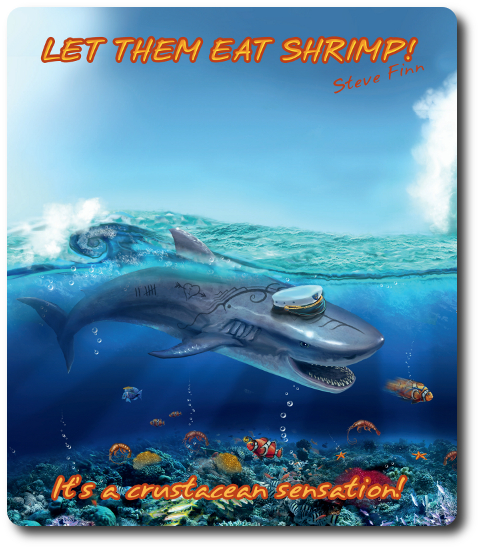
The Basics:
- For ages 6 and up
- For 2 to 5 players
- Approximately 30 minutes to complete
Geek Skills:
- Counting & Math
- Logical & Critical Decision Making
- Pattern/Color Matching
- Strategy & Tactics
- Visuospatial Skills
- Hand/Resource Management
Learning Curve:
- Child – Easy
- Adult – Easy
Theme & Narrative:
- The Bounty of the Sea comes at a price
Endorsements:
- Gamer Geek mixed!
- Parent Geek approved!
- Child Geek approved!
Overview
The ocean has been the subject of songs, poems, and paintings for as long as humanity cares to remember. Some believe it to be our birth cradle and others look upon it as a living force of nature. It’s the home of countless sea life and mysteries. It’s here you will compete to gather fish, fend off sharks, and prove you’re not all wet.
Let Them Eat Shrimp!, designed by Steve Finn and published by Dr. Finn’s Games, is comprised of 3 double-sided game boards, 140 Fish tiles (in hexagon, rhombus, triangle and trapezoid shapes), 5 Player shields, 5 Player mats, 35 Shrimp tokens, 35 Egg tokens, 1 custom six-sided Fish die, and 1 pawn (used in the advanced game). The component quality is excellent. The thick tiles and game boards will ensure the game will be playable for many game sessions to come.
Getting Ready to Dive
Note: Let Them Eat Shrimp! has a basic and advanced game mode. The basic game is summarized here. See “Game Variants” for details on advanced game play.
To set up the game, first place the game board pieces in the middle of the playing area. If playing with 4 to 5 players, use all 3 game boards. If playing with 2 to 3 players, use 2 game boards. In all cases, the game boards are connected along their long sides.
Second, take 1 triangle-shaped Fish tile and drop it above one of the game boards. Place this tile into the nearest space on the game board based on where the tile landed. If the tile bounces or lands off the board, drop the tile again. Repeat this step so each game board has 1 triangle-shaped Fish tile. These are the starting tiles.
Third, give each player 1 Player shield, 3 Egg tokens, and 1 shape of every Fish tile (4 in total). Players set the Player shield in front of them and place their Fish tiles and Egg tokens behind it. These tokens and tiles represent the player’s starting supply. Players should keep their supply hidden from their opponents at all times.
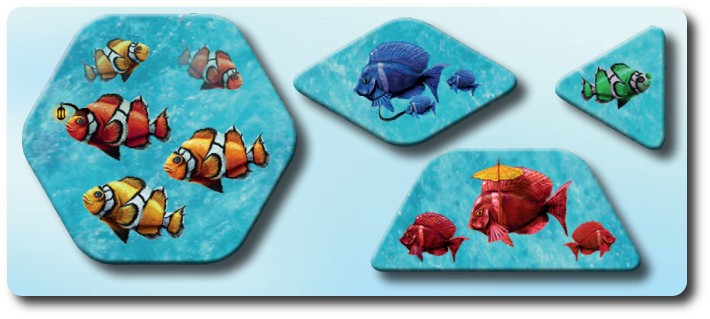
Fourth, place the remaining Fish tiles, Shrimp tokens, and Egg tokens to one side of the game playing area. This area is referred to as the “general supply” for the duration of the game.
That’s it for game set up. The Player mats and pawns are not used in the basic game. Place these game components, along with any Player shields or game boards not used back in the game box.
Decide who will be the first player and begin.
Under the Sea
Note: If you now have the song “Under the Sea” in your head, as sung by Sebastian the Crab in the Disney Movie “The Little Mermaid”, you are in good company.
Let Them Eat Shrimp! is played in turns with no set number of turns per game. A player’s turn is summarized here.
Step 1: Place One Fish Tile
The player takes 1 Fish tile from their supply and places it on the game board. The Fish tile must fit and not overlap another Fish tile or extend over the edges of the game board, but a Fish tile may cross from one game board to another. The game board is divided by a series of horizontal and diagonal lines the form a triangular grid. The grid is used to help visually identify what Fish tile shapes can go where. Fish tiles can extend past these lines if the Fish tile shape requires it, but Fish tiles cannot leave the defined boundary created by the lines.
When placing the Fish tile, it must be adjacent to another Fish tile so at least 1 of the newly placed Fish tile’s sides are touching an already placed Fish tile on the game board. It must be touching on a side, not a point. Selecting the best Fish tile shape is important. Using the different Fish tile shapes, a single Fish tile can take anywhere from 1 to 6 game board spaces.
If the player doesn’t have any Fish tiles in their supply, they must place 1 Egg token back to the Egg token general supply and then select 1 Fish tile of any shape from the Fish tile general supply. This newly acquired Fish tile is then played to the game board.
In the event that the player has neither a Fish tile or an Egg token, they are out for the duration of the game.
Step 2: Take One Action
The Fish tile might have covered 1 or more sea creatures illustrated on the game board. In total, there are 4 sea creature types. These are Fish Eggs, Shrimp, Starfish, and Sharks. Players should pay close attention to what was covered since it impacts what actions they can now take.
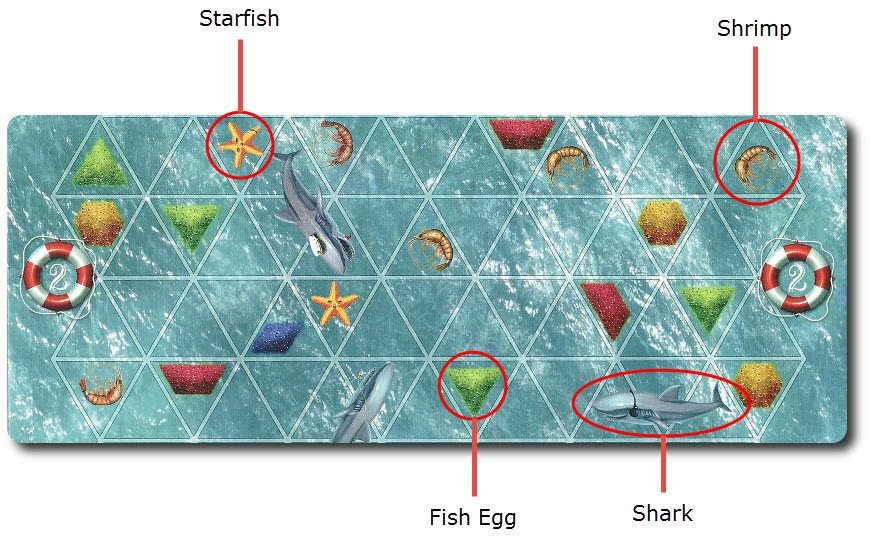
- For every Fish Egg covered, take 1 Fish tile that matches the shape of the Fish Eggs covered and place the Fish tile behind Player shield
- For every Shrimp covered, take 1 Shrimp token and place behind the Player shield
- For every Starfish, roll the Fish die and claim results
- For every Shark, roll the Fish die and lose the results
For the Starfish and Shark, the die results identify which Fish tile is either taken from the general supply and placed in the player’s personal supply or taken from the player’s personal supply and placed in the general supply. Starfish always allow the player to get more fish (adding it to their personal supply), while the Shark always “eats” a tile (sending it the general supply). If a player is ever required to return a Fish tile to the general supply that they do not have in their personal supply, they must return 1 Egg token instead.
The one exception is if the opposite type is rolled for the die. When rolling for a covered Starfish, a die result with a Shark indicates no loss or gain. Likewise, a roll of a Starfish after covering up a Shark means the player neither loses or gains anything.
If the player covers up more than one sea creature on their turn, they must resolve the actions in a specific order. The order is as follows:
- Fish Eggs
- Shrimp
- Starfish
- Shark
This ends the player’s turn. The next player in turn order sequence now goes starting with step 1 noted above. A player is only knocked out of the game during step 1. If they lose their last Fish tile or Egg token during step 2 due to a hungry shark, they are still in the game.
Ending the Feeding Frenzy
The game can end 1 of 3 different ways.
If all the players except one are knocked out, the remaining player is automatically the winner. Not the most satisfying of victories, but a win is a win. No final scoring is required.
If there is no legal opening to place a hexagon-shaped Fish tile, the game immediately ends and goes to final scoring. If the player didn’t want to place a hexagon-shaped Fish tile or there is room for legal placement of other Fish tile shapes, the game still ends.
If all the sea creatures illustrated on the game boards are covered up at the start of the player’s turn, the game ends and goes to final scoring.
Final scoring is calculated by counting tokens and tiles in a player’s personal supply. Each Fish tile can only be used once to score. If the Fish tile is not used to score a set, it’s worth zero points. Egg tokens can be used as a “wild” to represent any 1 Fish tile.
- Each set of 4 different Fish tile scores 5 points (a set is considered 1 triangle, 1 trapezoid, 1 rhombus, and 1 hexagon-shaped Fish tile)
- Each set of 3 different Fish tiles scores 3 points
- Each set of 2 different Fish tiles scores 1 point
- Each Shrimp token scores 2 points
Included on every Player mat is a visual breakdown of how to score the Fish tiles. Very useful during the game, as well, since it can help players decide which Fish tiles to play and which to keep.
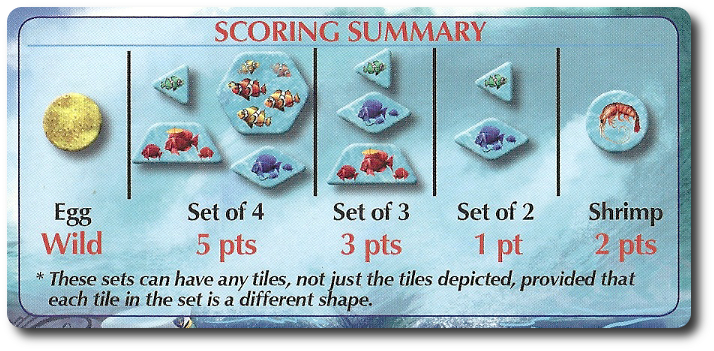
The player with the most points wins the game. Ties are first broken on number of Fish tiles still in the players’ personal supply, then by Egg tokens, and finally Shrimp tokens.
Game Variants
There are several game variants available for those who like to swim in deeper waters.
Advanced Game Mode
The advanced game mode removes luck from the game play. Game set up is the same, except 1 Player mat is given to each player and the pawn is given to the first player. After players received their initial personal supply of Fish tiles, they place 1 Fish tile per shape on their Player mat. If a player is unable to add all 4 Fish tiles to their Player mat, they must spend an Egg token to obtain the missing Fish tile. If they cannot obtain a new Fish tile, they are knocked out of the game. The Player mats are always visible to the player’s opponent’s.
Game play is broken into rounds. Players take turns per round, starting with the player with the pawn. On the player’s turn during the round, they select 1 Fish tile from their Player mat and place it to the game boards using the same rules in the basic game mode. The next player then places 1 of their Fish tiles. This continues until each player has 4 turns, placing the 4 Fish tiles on their Player mat.
If a sea creature is covered up, players use the actions described in the basic game mode for Fish Eggs, Shrimp, and Starfish. If any part of the Shark is covered up, the Fish die must be rolled for every triangle space covered where the Shark illustration is found. The die results are the same as noted in the basic game mode except that a roll of a Shark forces the loss of a Fish token and a Starfish forces the loss of a Fish tile of the player’s choice. So, the lesson here, kids, is stay away from sharks.
After a round is completed, the pawn is given to the player to the left of the previous starting player. The game ends in the same way it does in the basic game mode, either through lack of game board space or lack of players. Fish tiles on the Player mat are returned to the player’s personal supply for scoring.
The advanced game mode is interesting for two reasons. First, players must decide which Fish tiles they will be using for each round BEFORE the round begins. This forces a player to carefully consider what spaces are available and what might not be. Second, by seeing what other opponents have selected for the round, the player has to decide if they should play certain Fish tiles sooner rather than they expected.
More Time at Sea
If a longer game is in order with 2 and 3 players, add the 3rd game board during game set up.
Chuck the Luck
The Fish die randomizes the results of covering Starfish and Sharks. If you don’t like the die determining your fate, keep it in the game box. If a player covers up a Starfish, the player takes 1 Fish tile of their choice. If a player covers up a Shark, they lose 1 Fish tile of their choice. Simple.
Eggs vs. Sharks
If you just like a little bit of luck, this is a great way to keep the Fish die, but reduce its overall impact. Give each player 5 Egg tokens at the start. When the player covers a Shark, they lose 1 Egg token instead of rolling the Fish die. Additional Egg tokens are gained if the player covers a Starfish and rolls a Starfish on the Fish die.
Open Water
The Player shields are great for players to keep what Fish tiles they have in their personal supply a secret. If you would prefer a game where players have more information, remove the Player shields. Now every player knows what their opponent’s have and are missing. Should make for an interesting game, eh?
To learn more about Let Them Eat Shrimp!, visit the game’s web page.
Final Word
The Child Geeks had no problem grasping the most basic concepts of Let Them Eat Shrimp!, but age and experience were the determining factor on how strategic the placement of Fish tiles were. For example, all the Child Geeks understood how the Fish tiles were to be placed, including the few simple restrictions. The younger Child Geeks seemingly just placed to collect Fish tiles and avoid the sharks, while the older Child Geeks agonized about the proper orientation and location for specific Fish tile collection. According to one older Child Geek, “You really have to think about where you want to place your tiles or you’ll end up collecting tiles you don’t need to win.” True, but another younger Child Geek countered by saying, “No you don’t. You just need to get as many fish as you can and stay away from the sharks.” Both strategies are practical, with some obvious advantages and disadvantage. None the less, all the Child Geeks came together and voted to approve Let Them Eat Shrimp!
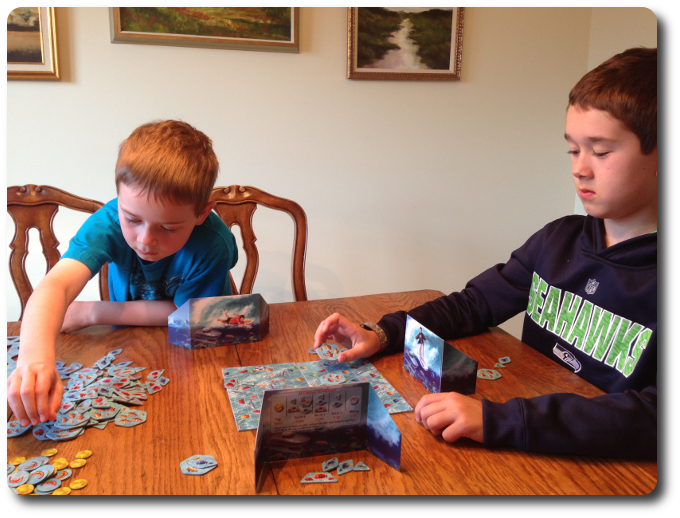
As one Child Geek ends their turn, another is already considering their options
The Parent Geeks found Let Them Eat Shrimp! to be casual and fun, with a good mix of strategy and light tactics. According to one Parent Geek, “This game has just the right amount of engagement to make it interesting without making it overpowering or overwhelming.” Another Parent Geek said, “It’s colorful and it’s fun to find the best location for each tile you place. I like how the game becomes steadily more difficulty as the amount of space decreases.” The only aspect of the game the Parent Geeks didn’t like was the constant placement and temporary removal of Fish tiles which was necessary to demonstrate where the Fish tile was being placed and then removed to collect the spoils it covered. Minor, but enough Parent Geeks grumbled about it to warrant a comment. Despite this small aggravation, the Parent Geeks voted to approve the game for their peers and their family.
The Gamer Geeks were mixed with it came to Let Them Eat Shrimp! Some of the Gamer Geeks found the game to be a good example of a light strategic game with tactical decision making and enjoyable depth of play. Other Gamer Geeks did not. According to one Gamer Geek who did not care for Let Them Eat Shrimp!, “The game would be good for families and non-gamers, but not for gamers. All we are doing is placing tiles and collecting tiles. And yes, I know what tiles you collect makes a difference, but the choices are always, always obvious. This game just isn’t holding my attention.” Another Gamer Geek who didn’t care for the game said, “Too simple and too light for me. Feels repetitive and hollow after a few rounds of play. Nothing really here.” The Gamer Geeks who enjoyed the game disagreed. One such Gamer Geek said, “This is not a simple tile placement game. Players lose their points every turn and must do all they can to get more points by collecting tiles. This is an outstandingly deceptive game of resource management that appears easy but is anything but.” Another Gamer Geek said, “What I really like about this game is its simplicity. Place a tile and take a tile. Easy, right? Wrong. You have to think things through, watch what your opponents are doing, and maintain your own stash of fish. This is a fun little game.” The Gamer Geeks, being opinionated elitists, couldn’t agree on how best to endorse Let Them Eat Shrimp! resulting in a mixed approval.
I really enjoyed Let Them Eat Shrimp! It challenged me to consider the value of each tile I was placing on the game board. Should I keep this Fish tile for a possible set? If I do, I won’t be able to use it to gain a lot of territory on the game board and possibly get more Fish tiles. For every Fish tile you lose, you have an opportunity to gain more, but as the game progresses, the amount of free space dwindles, as does the opportunity to obtain more Fish tiles. It’s a wonderful exercise in resource management and critical thinking.
But that is not enough to get me excited. The strategic game play and tactics used in both the basic and advanced game modes were entertaining, but it does start to feel repetitive. The only difference between one player’s turn and the next is the slightly reduced playing area to place a tile. While I would not go so far as to say that Let Them Eat Shrimp! feels boring or bland, the lack of big surprises and massive changes makes each round of game play feel almost identical to the last.
The only aspect of the game play I did not care for was the player elimination. Especially when used with the basic game mode that was intended for younger and inexperienced players. When you unceremoniously eject a player from the game, you are marginalizing their ability to interact with the other players. Consequently, the amount of fun to be had drops to zero and this leads some individuals to ponder why games should even be played in the first place. I would have preferred a different method of game play that would allow players to stay in the game, even if they were woefully short of Fish tiles. Then again, this is a resource management game, so it’s not necessarily incorrect to penalized a player who cannot manage their side of the Player screen. Still, I was left wondering if a better way was possible.
Despite the game giving players the boot, I still enjoyed this game very much. It perfectly fits as a casual game for the family and friends, as well as a filler for the gaming elitists who want to start their evening with something light. It’s clever use of tiles to earn possible points and the ever-shrinking opportunity to win generates an air of quiet desperation and urgency that is one part stressful and one part entertaining. You have to be on top of things to be the big fish in this game, which is not always easy to do. If you are looking for a challenging game that is easy to teach and easy to play, but by no means easy to win, then do dive into Let Them Eat Shrimp!
This game was given to Father Geek as a review copy. Father Geek was not paid, bribed, wined, dined, or threatened in vain hopes of influencing this review. Such is the statuesque and legendary integrity of Father Geek.



